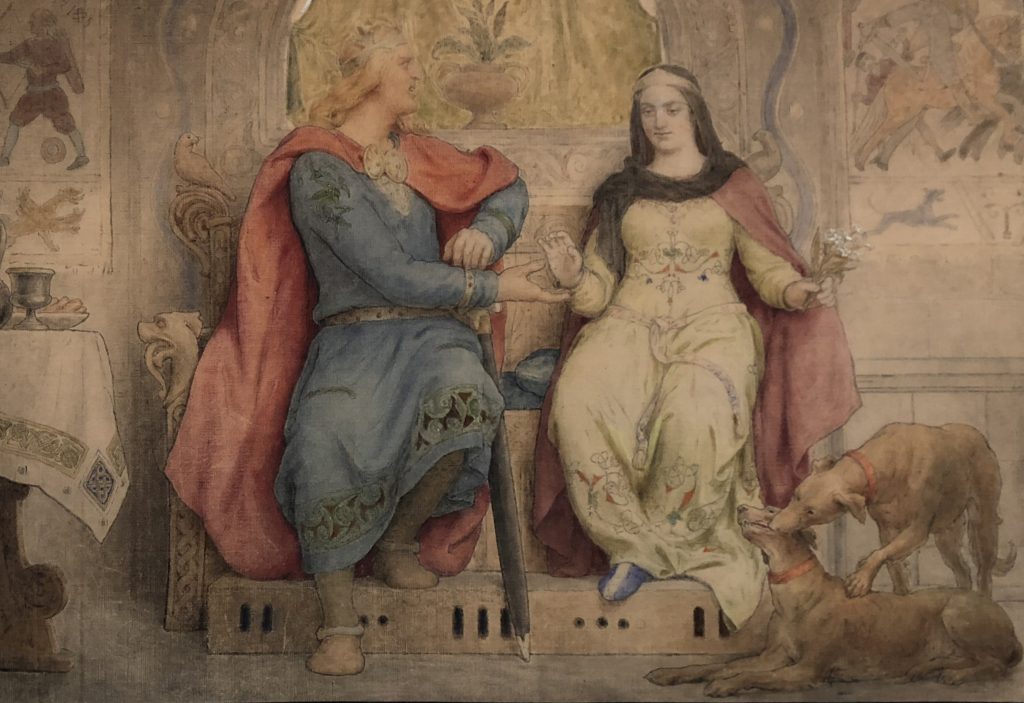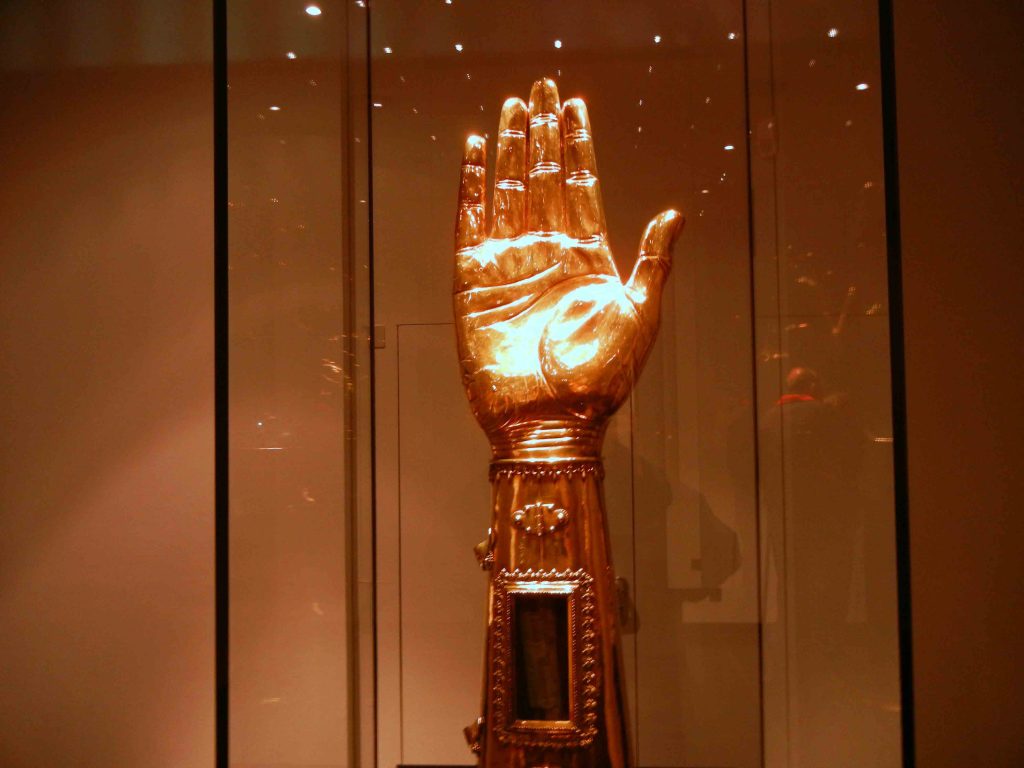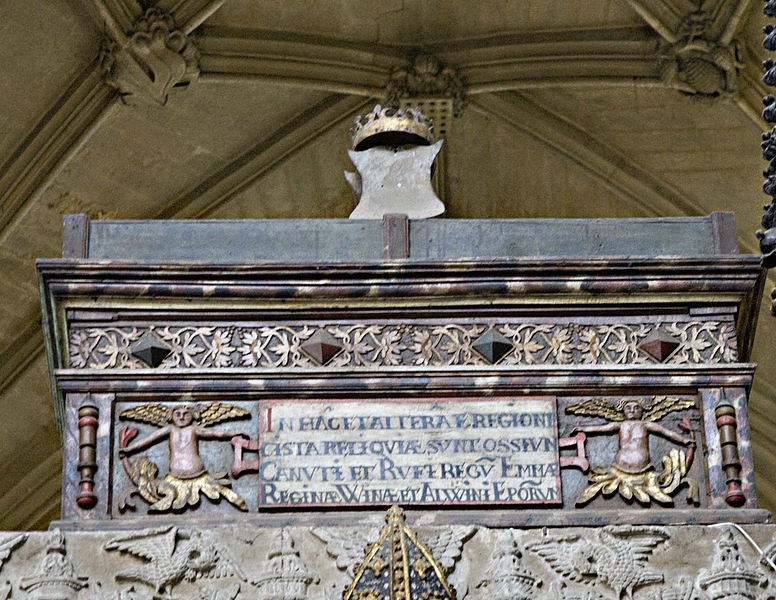
Despite the painting above of King Cnut wooing Emma of Normandy, this is not a love story. But it IS about Queen Emma and St. Valentine.
Emma of Normandy, Queen of England, was long remembered as a generous patron by the churches and abbeys of York, Canterbury, London, Winchester and Bury St. Edmund, as well as foundations in Germany, Scandinavia and France. Patronage—the giving of gifts—was a way of exercising queenly power, and a queen’s gifts were much sought after. Emma’s gifts took the form of textiles, such as altar cloths adorned with gold and precious stones; of gold cups; of silver shrines; of beautifully decorated manuscripts; and, especially, of relics encased in lavish gold and silver coffers.
Queen Emma was a great acquirer of relics, most of which she gave away. To the Christian faithful of the early medieval period, relics were far more than just mementos of the dead; or talismans offering protection and healing; or reminders of the afterlife of the soul. They were tangible links to the Divine, and they bestowed honor and privileges on the possessor. They were enshrined in churches all over Christendom, becoming focal points for pilgrimage. They were carried at the heads of armies as they went into battle—emblems of divine support. For example, Edmund Ironside’s army carried the relics of St. Wendreda into battle at Assandun. At battle’s end Cnut confiscated the relics. That St. Wendreda had allowed her relics to be taken by an invader was surely a sign that Cnut, and not Edmund, had her support; and Cnut was not about to toss away any advantage in his quest for the crown. So, although he probably knew nothing about St. Wendereda, instead of dumping the contents and keeping the reliquary for its valuable adornments, he carried it with him for the next year until he donated it to Christ Church Canterbury. (Who knows? Maybe at Emma’s suggestion.)

An example of an imposing & possibly portable reliquary
One of the relics associated with Queen Emma was the head of St. Valentine who, it was believed, was martyred in Rome in the 3rd century, presumably on 14 February, which became his feast day. In 1042 Emma gave this relic of St. Valentine to the New Minster, Winchester, and it was cherished as one of the church’s most valuable possessions. This was long before St. Valentine’s Day was mentioned in Chaucer’s 14th century poem Parlement of Foules as the day when birds choose their mates, associating it forever with lovers, candy, cards, and flowers.
But, you may ask, how did Emma come by the head of this beheaded saint in the first place? Well, at some time in the early medieval period, a Norman priest acquired the head of St. Valentine in Rome (possibly through nefarious means, it’s hard to say). He took it back to Normandy, to the abbey of Jumieges where he presented it to the monks and entered the monastic life there. In 1037 a close friend of Emma’s son Edward became the abbot at Jumieges, and in 1041 when this Abbot Robert accompanied Edward to England, he brought the relic with him. Either he gave it to the queen, or she purchased it from him. The following year, she gave it, in turn, to the New Minster at Winchester. It was still there 75 years later when the reliquary was opened and the head was washed.
When the New Minster was torn down in the 12th century to make way for a new cathedral, the monks moved into the nearby Hyde Abbey and they took the reliquary of St. Valentine and many others with them. The abbey, though, did not survive the Dissolution of Henry VIII’s reign, and St. Valentine’s head and reliquary are long gone. Nevertheless, some tangible evidence of this story remains. In Winchester’s beautiful Norman cathedral, the bones of Queen Emma and King Cnut are still preserved.

Photo: Wikimedia Commons
Sources:
Chaucer and the Cult of St. Valentine, Henry Ansgar Kelly
Cnut the Great, Timothy Bolton
Queen Emma & Queen Edith, Pauline Stafford
Portable Christianity: Relics in the Medieval West (c.700-1200), Julia M. H. Smith
www.metmuseum.org
Patricia – we are all patiently awaiting number 3. Can you give us a clue?
Hello Hugh, and thank you for your patience. The journey of a novel from manuscript to bookstore shelf is lengthy and tortuous. The manuscript of Emma’s third book is finished, but that’s only the beginning of its journey. Just now, I can’t tell you any more than that. Whenever I know more, (hopefully soon), I will be posting it here, on my Facebook page and in my Newsletter.
I am dying for your third book!! Any updates?
Hi Stefanie. I’m sorry to keep you waiting, but I have no updates to share just yet. The manuscript is with my publisher in New York, and the ball is in their court. Like you, I’m waiting, holding my breath.
Hugh, you are waiting patiently but I am dying for the 3rd book!!